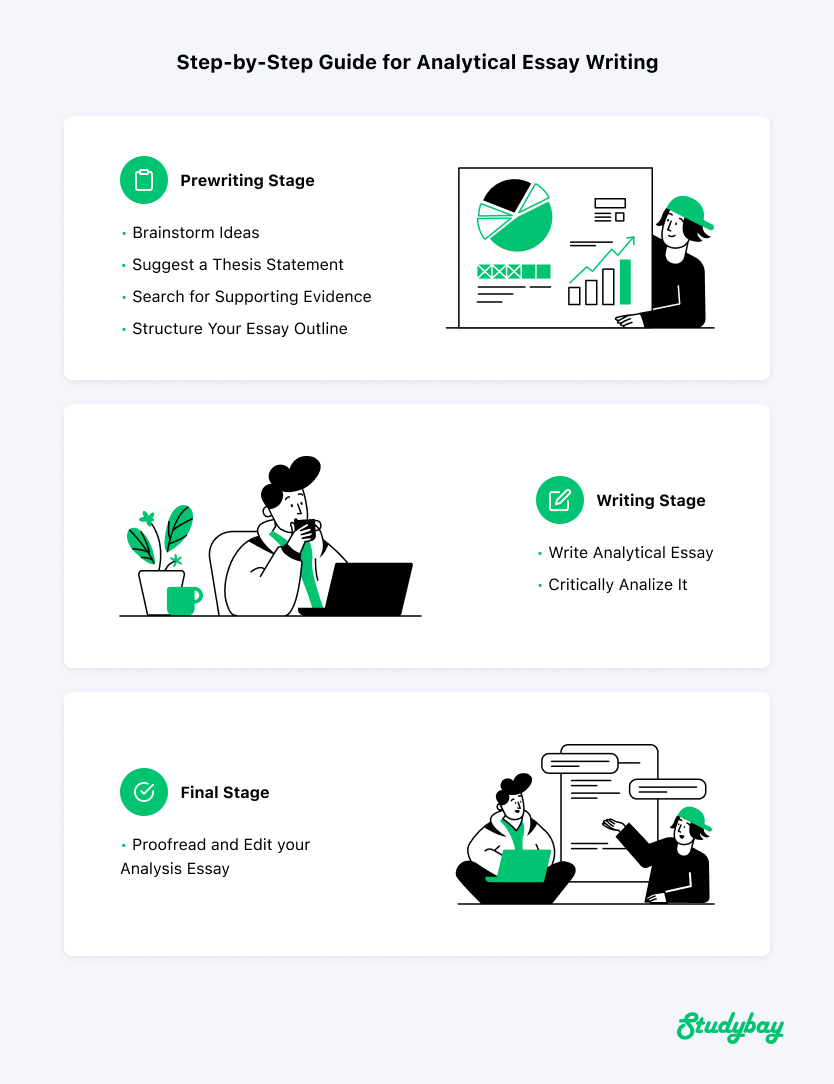
18 min
0
10.17.2022

An analytical essay is a genre of essay, a piece of writing that presents an analysis of any event, occurrence, or literary form. You need to have a firm grasp of the topic you intend to analyze. There are other factors also that you should keep in mind when doing analytical writing. Here is a step-by-step guide that will help you.
- Step-by-Step Guide for Analytical Essay Writing
- The Writing Stage
- Post Write Up Stage
- Tips to Write an Analysis Paper
- Thesis Statement Example
- Analytic Essay Examples
- Frequently Asked Questions
- What is the definition of an analytical essay?
- What is analytical writing?
- What kind of essay is an analytical essay?
- Do I need to include evidence in my analytical essay?
- What is a thesis statement?
- What are the major differences between an analytical essay and a descriptive essay?
- What is an analytical paper for?
- How to start an analysis essay?
- How long should an analysis essay be?
- How do I know if I should add works cited to my analytical essay?
- Should I always add works cited to my analysis essays?
- Is there a general rule of thumb for adding works cited?
Step-by-Step Guide for Analytical Essay Writing
It is time to guide you on how to write it through our easy step-by-step guide. Let us divide it into three stages for better understanding.
Prewriting Stage
During this stage, you don't have to write anything, but you must prepare yourself and your mind about how you are going to do it.
Understand the Purpose of the Essay
The first step in writing an analysis essay is to understand the main objective of the essay. What do you want to proclaim during your analysis?
Whether your given topic is about a literary piece of writing or analyzing an event, it must provide factual evidence to support your argument.
Decide What You Have to Write About
Read the specific guidelines your teacher has given you. What does it say? Has your teacher assigned you a topic, or do you need to select it on your own? If the professor has asked you to choose your topic, you should go for something you know well. Here are a few things to consider when choosing essay topics:
- The topic is unique;
- You are truly passionate about the subject;
- There is factual evidence available;
- You can find relevant information on the topic;
- The topic falls into the category suggested by your teacher.
Brainstorm Ideas
Think about what you are going to discuss in the essay. Discuss it with your peers and teachers. Jot down your ideas on a piece of paper so that you have a clear mind when you sit down to write. Brainstorming ideas will help you maintain your focus and bring in creativity.
Suggest a Thesis Statement
As mentioned above, you have to present your thesis statement in the introductory paragraph. Before writing a thesis statement, you should know what it would contain. There are a few things you must consider when thinking about the thesis statement:
- It should be specific;
- It should only cover what you intend to discuss in the paper.
Search for Supporting Evidence
Before you sit down to write, find the relevant evidence and information. Read the literature review and find factual evidence supporting your document from various websites, articles, and research papers. This will help you present the literary analysis as if it is a work of art.
Structure Your Essay Outline
Another major step needed to complete the prewriting phase of an analytical essay is to structure the outline of a specific topic. Once you have enough information, you can jot down the main points revolving around the main characters to structure a perfect essay outline.
The Writing Stage
When you sit down to pen down the critical analysis of a historical event, you need to break it down into three major paragraphs, as discussed above.
Write the Thesis Statement
Write the introduction, keeping the reader's attention in mind. It should have a hook that lures the reader to read further. If the topic is assigned, you must use the following tips to write a compelling thesis statement:
- Convert your problem statement into a question;
- A good thesis statement should take on a subject on which many people won't agree;
- It would help if you dealt with a subject on which some background information can be found out;
- Express the main purpose of your analysis or idea;
- Tie up all your thoughts in one sentence;
- Remember, you can't take both sides of the story in a thesis statement;
- Backup your thesis statement with factual evidence;
- You can't be vague when presenting the main idea of your critical analysis;
- Be specific and present the problem in a clear, concise manner.
Critically Analyze
Start the body paragraphs with the strongest points. If it is scientific research, you are analyzing, critically review the body paragraphs' scientific method.
All body parts must have a single topic sentence. They should be presented using a single main idea. When writing the body part, start with one idea and elaborate on it in the remaining paragraph. Here are a few points to consider when writing body parts:
- Keep the number of paragraphs in the body to as much as you want to discuss;
- If it is a lengthy topic, then you shouldn't stick to the traditional 5-paragraph essay; it can be as long as required;
- You may incorporate quotes from the source;
- Or paraphrase the quotes depending on how long the quote is;
- Don't forget to include citations when mentioning any quote;
- The citation would include title, author, and year of publication.
Concluding Note
The writing process of an entire essay is incomplete without wrapping it up on a concluding note. The conclusion must tie everything together. Here are a few things you should remember when writing the conclusion:
- It should provide the analysis in a finalizing way;
- No new point should be introduced here;
- It shouldn't be a summary of what you have already written;
- The concluding note doesn't need to be wrapped up in a single para;
- The conclusion can spread over to a maximum of 3-4 paragraphs depending upon how complex and lengthy the critical analysis is;
- After the conclusion, there should be a reference list and appendix;
- Whatever you don't cite would be considered your own opinion. Therefore, it is quite important to state the author's name and give the citations required to avoid plagiarism.
Post Write Up Stage
Once you have penned down a good analytical essay, you must now edit and proofread it as a teacher or a knowledgeable person. Only then will you be able to pinpoint mistakes. Make sure it is error-free, as your teacher would grade you on it. You can read it out loud to identify the mistakes or ask your friend to read it for you carefully. Once you are sure that the content is plagiarism and error-free, you are now ready to submit it!

Tips to Write an Analysis Paper
If you have followed the above structure and format, you now have a compelling essay ready. However, you must consider a few tips before you call it a day. To write an analytical essay, there are a few tips to follow:
- Your essay must follow clear guidelines stated by your professor;
- Remember, this is not a five-paragraph essay you used to do in high school. It requires more detail and analysis;
- All paragraphs must have a strong beginning and end;
- The introductory paragraph should be smoothly transitioned into the remaining paragraphs;
- Don't use the first or second-person narrative;
- You should not make a summary and use long descriptions;
- Ensure that the essay follows a logical structure and sticks to the outline;
- Don't allow secondary sources to overpower the research work;
- Make sure the essay has the perfect length as mentioned in the guidelines;
Thesis Statement Example
We hope our step-by-step guide and detailed tips on how to construct a compelling essay to secure good grades will help you! Make sure to follow everything as described. Another friendly tip is not to worry and stress yourself out! You can do it quite well only if you remain focused and have done your homework well. Rest assured, everything will fall into place - just the way you want!
Here are a few examples of analytical essay thesis statements. Note that the following statements have not all been thoroughly researched. The point of them is to help you know how to write your own thesis statement.
Example 1: Literary. Sir Gawain and the Green Knight reveals a preoccupation with Christian materiality typical of the Middle Ages, illustrating the belief that divinity was accessible through the physical.
Example 2: Historical. While the practice of magic was officially frowned upon in medieval Islamic culture, existing amulets, talismans, and magic bowls demonstrate a contradiction between orthodoxy and lived experience.
Example 3: Scientific. Originally hailed as a reliable source of renewable energy, studies show that wind turbines may not be an ideal solution due to the negative impact they have on wildlife and agriculture.
Critical Analysis Example
Here is an example of a paragraph of critical analysis from an essay about the 1899 novella Heart of Darkness, by Joseph Conrad. If you are still wondering how to write a body paragraph for an analytical essay, this example will prove helpful:
While a deeply influential novella that came out of the 19th century, Heart of Darkness is a problematic text by today's standards. Conrad's treatment of race within the text is troubling to a modern-day viewer. Throughout the entirety of the novella, he portrays the native Africans of the story as unsophisticated and backward. He even goes so far as to compare the ship's Black fireman to “a dog in a parody of breeches and a feather hat, walking on his hind legs.” But where the text's racism is most pervasive is in the description of the land itself. Africa is portrayed as an unfettered beast, “monstrous and free.” The entire continent is associated with darkness—darkness of both a spiritual and intellectual kind, as well as literal. By association, its people are painted as wild and degenerate, in desperate need of guidance from European colonizers.
Concluding Note Example
Here is an example of a concluding paragraph from an analysis of the impact of nature on physical health. This should provide you with a good reference point for writing an analysis essay conclusion:
To conclude, as this essay has shown, the impact of the human-nature relationship on physical health and wellbeing cannot be denied. By approaching the subject through an interdisciplinary lens, bringing together environmentalism, evolutionary psychology, and evolutionary biology, we can better understand this link. From helping to regulate our natural bodily rhythms, reducing blood pressure, and improving mental health, the benefits of spending time out in nature are far-reaching and crucial to our wellbeing.
Analytic Essay Examples
In this section, we will present two examples of good analysis essays to help you figure out how to write an analysis essay. This will help you see for yourself what an analytical essay is and will provide you with a good example of analytical essay writing. The first will be a decently written paper, accompanied by critiques and suggestions. The second paper will incorporate these suggestions, presenting a more polished version of the first essay. By examining these examples, you should get a clear sense of how to write an analytical essay.
Example 1:
Guillermo del Toro's Pan's Labyrinth was released in 2006 to critical acclaim and box office success. The dark fantasy film is set in 1940s Francoist Spain and surrounds ten-year-old Ofelia as she struggles beneath the tyrannical force of her oppressive stepfather, the fascist Captain Vidal. Ofelia encounters a Faun in a labyrinth on Vidal's estate who tells Ofelia she is the reincarnation of Moanna, the Princess of the underworld, and that to return to her kingdom she has to complete three trials. It's unclear whether or not Ofelia is in fact the reincarnated Moanna or whether she's making this up. However, del Toro gives both the real and the fantastical worlds an equal amount of attention.
In Pan's Labyrinth, Ofelia's fantasy world has warm colors which make the fantasy world more attractive than the real world with its blues and greens. This color scheme shows that Ofelia feels that she fits into the fantasy world more than the real one.
It's in the world of the Faun that Ofelia finds herself and turns into a young girl capable of taking on the challenges of the real world. In many ways, Pan's Labyrinth can be seen as a coming-of-age story. In the real world, our young protagonist is not permitted to grow. She is stifled both by her stepfather's oppressive force and by her mother's expectations. However, she can in the world of the Faun.
Vidal's world, the world of Francoist Spain, is a cold one, both visually and literally, but there are bits of warmth. The hill-dwelling rebel fighters as well as Vidal's housekeeper, a secret friend to both Ofelia and the rebels, are infused with warm colors. Ofelia, the housekeeper, and the rebels are all associated with disobedience, going against Vidal and his regime. In Ofelia's case, she also disobeys the final command of the Faun to sacrifice her newborn brother to regain her place in the underworld. It is this disobedience that ensures her moral victory.
By connecting the worlds of Francoist Spain and the world of the Faun, del Toro shows how disobedience is a necessary force. Regardless of whether one believes the Faun's world to be real or not, this is the message one should take away from del Toro's film: embrace disobedience.
Critiques:
- Unclear thesis statement. Reading the introductory paragraph, it is unclear what exactly the main argument of the essay is. It seems it will be talking about del Toro's treatment of the real and fantastical worlds of the film, but it gives no clue as to how or to what ends.
- No textual evidence or quotations. The essay raises some interesting points. But, the author hasn't included any evidence to support their argument.
- Gaps in the argument. This is a relatively convincing essay with a clear line of argument. However, there are parts that could do with elaboration to make it easier for the reader to follow along.
- Weak conclusion. Since del Toro's use of color theory formed the main part of the essay's argument, it should be mentioned in the final concluding thoughts.
- Lack of topic sentences. The essay would benefit from clear topic sentences at the very beginning of each paragraph to make it clear what the main point of the paragraph is.
- Informal language. Usage of contractions makes your work read more informally—unsuitable for an academic setting.
Example 2:
Guillermo del Toro's Pan's Labyrinth was released in 2006 to critical acclaim and box office success. The dark fantasy film is set in 1940s Francoist Spain and surrounds ten-year-old Ofelia as she struggles beneath the tyrannical force of her oppressive stepfather, the fascist Captain Vidal. Ofelia encounters a Faun in a labyrinth on Vidal's estate who tells Ofelia she is the reincarnation of Moanna, the Princess of the underworld, and that to return to her kingdom she must complete three trials. It is unclear whether or not Ofelia is in fact the reincarnated Moanna, or whether this is a figment of her lively imagination. However, del Toro gives both the real and the fantastical worlds an equal amount of attention, using color theory to unite them both into a cohesive whole that has something to say about the importance of disobedience.
Del Toro is a master of his craft, known for his striking use of stylized color and sharp, dramatic lighting. In Pan's Labyrinth, Ofelia's fantasy world features warm colors—“deep crimsons and golden ambers, almost like amniotic fluids,” according to del Toro (“Pan's Labyrinth, shot by Guillermo Navarro, ASC, marries the horrors of war-torn Spain with the surreal visions of an imaginative girl,” American Cinematographer, January 2007). Despite its horrors, this makes the fantasy world more enchanting, more attractive than the real world, colored with cold blues and greens. This color scheme also conveys an important message about Ofelia and her state of mind. Whether or not the fantastical world of the Faun exists is immaterial: either way, she feels that she belongs there. It has warmth and a feeling of belonging in a way that the cruel world of violence she knows does not.
That del Toro compares his color scheme with that of amniotic fluids is telling. It paints the fantasy realm as a sort of womb: a place of transformation and birth. Fittingly, since it is in this place Ofelia finds herself and transforms into a young girl capable of taking on the challenges of the real world. In many ways, Pan's Labyrinth can be seen as a coming-of-age story. But where our young protagonist is not permitted to grow in the real world, stifled both by her stepfather's oppressive force and her mother's expectations, she can in the world of the Faun.
Disobedience is the driving force behind this change—and it is the theme of disobedience that ties these worlds together. Vidal's world, the world of Francoist Spain, is a cold one, both visually and literally, but a few tendrils of warmth do manage to invade it. The hill-dwelling rebel fighters as well as Vidal's housekeeper, a secret friend to both Ofelia and the rebels, are infused with warm colors. Ofelia, the housekeeper, and the rebels are all associated with disobedience, going against Vidal and his regime. In Ofelia's case, she also disobeys the final command of the Faun to sacrifice her newborn brother to regain her place in the underworld. It is this disobedience that ensures her moral victory.
By connecting the worlds of Francoist Spain and the world of the Faun through his use of color, del Toro shows how disobedience—the propulsive force which drives Ofelia's growth and her story— is a necessary force for survival (“Pan's Labyrinth: Empowering a Young Girl Through Imagination, Motherhood, and Disobedience,” Indiana University Blog, Spring 2020). Regardless of whether one believes the Faun's world to be real or not, this is the message one should take away from del Toro's film: embrace disobedience.
Frequently Asked Questions
What is the definition of an analytical essay?
The definition of an analysis essay is a piece of writing that provides an in-depth analysis of your own topic of choosing to argue a particular point. This can be anything from a historical event or a scientific study to a piece of art or literature. Regardless of the subject matter, the purpose of this kind of essay is to provide an analytical interpretation of a topic to support your claim. Analysis essays are a common form of academic writing but also appear in newspapers, magazines, and journals.
What is analytical writing?
A definition of analytical writing would describe it as critical and expository. Analysis in an essay should carefully examine the event or piece of media in question, breaking it down into its disparate parts. Each element is evaluated in detail. A well-written analytical response should present a particular argument or claim and should aim to convince the reader of it.
What kind of essay is an analytical essay?
Analytical writing aims to increase the reader's understanding of a topic by presenting a thorough examination of each of its separate elements. This exploration should lead the reader to draw particular conclusions. The writer is expected to gather and present evidence to support an analytical claim about their essay topic.
Do I need to include evidence in my analytical essay?
It's always best to include evidence in your analysis essay. Where you can, it's good to include contrasting opinions to your own. It can also make your essay seem more thought out if you back up a bold statement with a quote or other piece of evidence. If you're wondering how to write an analysis paper that is compelling and convincing, this is a key step.
What is a thesis statement?
A thesis statement is an introductory sentence explaining the argument of your essay. When thinking about how to write your analytical essay, think about how you can summarize your main points in this introductory sentence. Your thesis statement is the backbone of your paper, so it's important to figure it out early.
What are the major differences between an analytical essay and a descriptive essay?
The point of a descriptive essay is to get the writer to describe something. This could be an event, an individual, a feeling, or something else. A good analysis essay will convince the reader of a particular claim, whereas a descriptive essay simply depicts something for the reader. When written well, a descriptive essay should allow the reader to feel almost as if they're experiencing the event themselves.
What is an analytical paper for?
The purpose of an analytical essay is to convey a convincing argument to help your reader see things from your point of view. This topic could be anything from a piece of media to a scientific study. Whatever the topic, however, the writer should break down each element of the subject in question to argue a specific point about it.
How to start an analysis essay?
A good introduction to an analytical paper will contain a few key elements. Within the opening few lines of your analysis essay, you should include a thesis statement: a brief sentence summarizing your analytical argument, or main point. Your essay introduction should contain the necessary context for your analysis paper, and should also feature a hook to grab the reader's attention. Avoid dramatic introductions and instead focus on making the point of your essay clear. Look up an analytical essay introduction example if you're not sure where to begin.
How long should an analysis essay be?
Your analytical essay format and length will vary depending on what level you are writing at, what subject you are discussing, and what your original brief for the assignment was. That said, analytical essays are commonly around 500 words long. The typical analysis essay structure for a work of this length includes an introduction, about three body paragraphs and a conclusion.
How do I know if I should add works cited to my analytical essay?
If you have to write an analytical essay for high school or university, your teacher should make it clear to you whether or not a list of works cited should be included. However, if you are unsure, it's always best to include one just in case.
Should I always add works cited to my analysis essays?
It's best to include works cited if you're not sure whether or not they're required. Including works cited presents your essay in a more professional, official light. It also will help you avoid any possible accusations of plagiarism.
Is there a general rule of thumb for adding works cited?
Generally, it's considered a good idea to add works cited even if you're not sure whether you need to or not. If you are specifically told not to include works cited, you can leave them out. Otherwise, it's best practice to include them.



